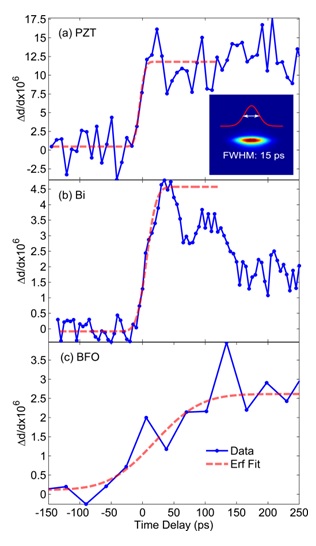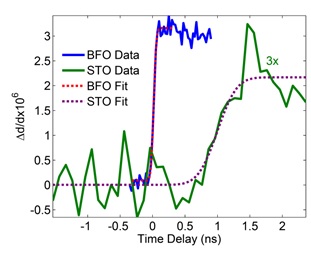
Fig. 1. Fractional changes in (a) PZT, (b) Bi and (c) BFO lattice spacings Dd/d measured with the (003), (222) and (220) reflections, respectively, collected in the short-pulse low-a mode. The inset shows a streak camera measurement of the x-ray pulse duration.
Ultrafast x-ray diffraction techniques typically utilize synchronized laser pulses as a trigger with x-ray pulses as a probe to provide direct structural information about the non-equilibrium behavior of materials. Specifically, a laser pulse impinges upon the sample to be studied, inducing various material-dependent excitations. An x-ray pulse is then incident on the sample, is scattered, and detected. By varying the time delay between the arrival of the laser pulse and the x-ray pulse on the picosecond scale, one can stroboscopically detect the transient structure of the optically-pumped system. Whereas experiments have primarily been carried out in a low-repetition-rate regime and under strongly non-equilibrium conditions, a key consideration is the development of techniques that enable atomic-scale resolution, real-time probes of materials and devices in a near-equilibrium, weakly perturbative regime - an effort complimentary to lower repetition-rate free-electron-laser-based studies where samples are typically strongly perturbed by pump and probe.
Scientists at the Stanford Synchrotron Radiation Lightsource (SSRL) and Stanford University, in work led by Mike Kozina and Aaron Lindenberg and in collaboration with David Reis and Apurva Mehta, have carried out experiments in a new hybrid low-a operating mode of SSRL’s SPEAR3 storage ring. In this mode, which provides 15 picosecond x-ray pulses at 1.28 MHz repetition rate, the trajectories of the electrons in the storage ring are adjusted to enable shorter electron bunch durations. A single timing bunch provides 15 picosecond stroboscopic sampling while the remaining bunches in the ring are filled to higher currents in order to preserve the overall average current for other users.
This work, published in the journal Structural Dynamics (Kozina et al. 1, 034301 (2014)), demonstrates the ability to probe strains at the sub-part-per-million level in nanoscale thin films (corresponding to <100 femtometer lattice displacements over a 100 nm thick film) and with a temporal resolution significantly better than those obtained in standard operating modes at synchrotrons. These techniques were applied to probe optically-induced structural changes in several different thin film samples relevant to microelectronic and thermoelectric applications.

Fig. 2. Fractional change in BFO film (blue) and STO substrate (green) lattice spacings.
The studied materials included the following thin films: Bi on sapphire, BiFeO3 on SrTiO3 (BFO on STO) and a complex heterostructure consisting of a Pb(Zr,Ti)O3 film (PZT) on a SrRuO3:SrTiO3:Si substrate (Fig. 1). The small-bandgap Bi sample was excited with a 515 nm laser pulse, inducing acoustic excitations in the sample manifested as long-period structural oscillations. Because of their larger bandgaps, the PZT and BFO films were excited with 343 nm light, with the initial electronic excitation leading ultimately to structural changes associated with photoferroelectric responses and strong coupling between electronic and lattice degrees of freedom in these materials. The PZT film showed a very rapid, temporally limited reaction, thereby acting as a metric for the time resolution of the experimental setup. The BFO film exhibited a slower response than seen in previous experiments with higher powers, suggestive of two different excitation regimes.
In addition to observing structural changes in the top-layer thin films, these measurements were capable of resolving the dynamical strains associated with thermal and phonon transport across interfaces. Understanding of thermal transport across interfaces has become increasingly important as the need for rapid thermalization in microelectronics and the opposite desire for large thermal boundary resistance in nanostructured thermoelectric devices develop. Following photoexcitation of the top BFO layer, the response of the underlying STO layer was observed to be delayed by approximately 1 nanosecond, indicating the presence of a thermal boundary resistance between these two materials (Fig. 2) and resolved for the first time using these novel techniques.
M. Kozina, T. Hu, J. S. Wittenberg, E. Szilagyi, M. Trigo, T. A. Miller, C. Uher, A. Damodaran, L. Martin, A. Mehta, J. Corbett, J. Safranek, D. A. Reis and A. M. Lindenberg, "Measurement of Transient Atomic Displacements in Thin Films with Picosecond and Femtometer Resolution", Struct. Dyn. 1, 034301 (2014), DOI: 10.1063/1.4875347




